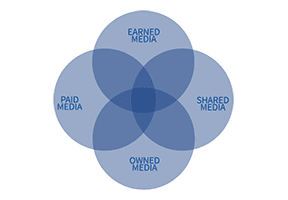Editor’s Note: This article was originally published by Web Marketing Today. Practical Ecommerce acquired Web Marketing Today in 2012. In 2016, we merged the two sites, leaving Practical Ecommerce as the successor.
We are in a period when banner advertising seems to be on the wane. You know, those rectangular boxes on commercial sites. Click-through rates have dipped to 0.20% for average banners and to about 0.50% for rich media banners, according to the Eyeblaster Analytics Bulletin for March 2009. That’s horrible! Are banner ads dead as a viable form of advertising? Not really. A great many companies, large and small, still use banner ads as part of their advertising mix and will continue to do so. Nevertheless, advertisers are becoming more sophisticated about when and how to use banner ads.
Defining Terms
To explore this broad and evolving type of advertising we need to begin by defining some terms:
- Hits — A fuzzy term meaning the number of times a webserver has been “hit” by a request for a webpage or a graphic image. Since perhaps 5 out 6 “hits” are for graphic images, the number of “hits” can be grossly misleading. Usually people mean by “hits” the number of times a webpage has been seen, but to be precise, the better term is “views,” “pageviews,” or (more sophisticated) “impressions.”
- Page impressions or pageviews — Refers to the number of times a webpage has been requested by the server.
- Banner views or impressions — Refers to the number of times a banner has been viewed. Almost the same as “page views,” but some banner server programs don’t count the banner view unless the visitor stays on the page long enough for the banner to be fully downloaded from the banner server.
- CPM — A metric from the print advertising, meaning “Cost Per Thousand,” using the Roman numeral “M” to stand for one thousand. A price of $15 CPM means, $15 for every thousand times a banner is displayed.
- Banner ad — An ad graphic hyperlinked to the URL of the advertiser. These are sometimes static graphic images, but animated rich-media banners do much better. The most common banner size used to be 468 x 60 pixels (Full Banner). To standardize, the Internet Advertising Bureau (IAB) specifies ad sizes in their Ad Unit. The sizes they’re recommending these days are 300×250 (Medium Rectangle), 180×150 (Rectangle), 728×90 (Leaderboard), and 160×600 (Wide Skyscraper). In fact, I don’t see people following these IAB size recommendations very closely. You’ll see a lot of 125×125 (Square Button) on sites, too.
- Creative — “Ad-speak” for the actual banner graphic.
- Click — When a visitor clicks her mouse on a banner ad, she is transferred to the advertiser’s site. The number of responses to a banner ad is sometimes refereed to as the number of “clicks.”
- Click Throughs — Same as “click,” commonly used to count the number of visitors who click on the banner and are transferred to the advertiser’s site.
- Click Through Rate (CTR) — The percentage of click throughs to banner views. A 1% CTR means that 1% of each 1000 banner views (or 10 visitors) have clicked through.
- Conversion Rate — The percentage of shoppers in an online store who actually make a purchase. This varies a great deal, and depends a great deal on the quality of the landing page.
- Cookies — Small files written to your computer when you view a banner ad, visit a website, or put a product in a shopping cart. This helps the banner server to keep from showing you the same ad, or perhaps show you ads you might be more interested in seeing. Cookies are controversial, but are here to stay; too much of the Web is run by cookies to get rid of them. Cookies also allow an advertiser to track which banner ad a visitor saw that brought him to the advertiser’s site, and which banner ads resulted in actual sales.
- Run of Site (ROS) — Refers to displaying a banner ad throughout a website or a banner network with no targeting by keyword or site category. Run of site advertising will probably cost less than more targeted advertising.
How Do You Measure Success?
Click Through Rate (CTR). This is a basic measure of how effective an ad is. CTRs range from the industry average of about 0.20% to as high as 5% or 10%. As a general rule, the more targeted the site, the higher the CTR. For example, you’d expect an ad for Wilson Tennis Racquets to get a higher CTR on a tennis site than on a general sports site. On a general site such as MSNBC they would get an even lower CTR. (Disclosure: I hold no financial interest in Wilson Sporting Goods, but wish I did.)
Cost Per Sale. A much more important figure is the actual cost of making the sale of a tennis racquet. In the final analysis, you don’t care how high the CTR is if it doesn’t result in a proportionate number of sales. What complicates this is the fact that your banner ads on the World Tennis Ratings site may actually sell fewer tennis racquets than those on NCAAChampionships.com. You can only make this determination when you use sophisticated tracking methods using cookies to separate the lookers from the buyers, and determine which sites and which banner ads had the best result. Most ad serving software, ad networks, and affiliate program software and services provide this kind of information. You can also determine this by coding all banner ad links.
Branding. While CTR and cost per sale relate to direct marketing objectives, another way of looking at banner ads is as “branding” tools. They create brand awareness, and a brand image in the viewer’s mind, whether or not the viewer clicks on the ad. But hopefully, when the viewer gets ready to make a purchase, those “impressions” (a wonderful ad agency buzz word!) will cause you to select Coca Cola over Pepsi, or Barnes and Noble over Amazon, or JCrew over Lands’ End. Branding is very difficult to measure, but can be very powerful. Typically, only the larger and better-established companies have the budget to pursue branding consistently. Brand awareness is sometimes measured in surveys with questions such as: “What brand names can you recall in the field of tennis?”
CPM Banner Economicss
While brand marketers may assess effectiveness in some fuzzy way, direct marketers look at any advertising method in terms of how many sales it produces immediately. Let me give you an idea of how the numbers might look for banner ads. Your results will vary, depending upon where you advertise and the effectiveness of your creative. Here are some arbitrary numbers to use in our calculation:
- CPM = $2 (a not untypical rate for general, not-very-targeted websites)
- CTR = 0.20%
- Conversion Rate = 2% (from your landing page)
Cost per Visitor = CPM / (1000 x CTR) = $2.00 / (1000 x .002) = $1
In our example, the $2 you spent to show the banner ad to 1000 people netted you 0.2% or 2 visitors to your site. Each visitor cost you $1 to get there. Hmmm. Now let’s calculate what your advertising cost is per sale. At a 2% conversion rate from you landing page it would take 50 visitors to make one sale.
Cost per Sale = Cost per Visitor / Conversion Rate = $1.00 / .02 = $50
Oops! You mean it costs me $50 to get one sale? Yes, Virginia. Of course, if you have a 10% conversion rate (like a few top merchants) rather than a 2% conversion rate (which is high for many small businesses), it only costs you $10 to get a sale.
Lower Cost Approaches
What this means is that banner advertising on a CPM basis can be expensive. First, you need to determine what cost per sale you can afford. Then consider these alternatives:
- Reduce your CPM. Ad agencies specialize in placing ads on selected sites. They usually work on a CPM basis, and often make their money by purchasing the ad space at a 15% to 20% agency discount. Tell your ad agency the most you can pay and don’t budge. There are hundreds of ad networks that specialize in placing clients ads on a network of “quality” sites that they can serve banners to. Out of your CPM rate, the publisher site gets a portion and the ad network company gets the rest. Try negotiating a lower rate!
- Find a PPC or CPC ad network. The advertiser is king — it’s an ad-buyer’s market these days. Some ad networks only charge you when you get a click-through, thus you Pay Per Click (PPC) or on a Cost Per Click (CPC) basis. Now you don’t have to pay for banner impressions seen by people who aren’t interested at all. Note: The line between pricing methods is fuzzy these days. Some networks offer your choice of pricing approaches — or a combination of two methods.
- Start an Affiliate Program. Affiliate programs work on a Cost Per Sale (CPS) or Cost Per Action (CPA) basis. You pay a fixed amount only when you get an actual sale or lead! Affiliate program software or service organizations will host your banners and make them available to affiliates.
- Add Google AdWords PPC text ads to your advertising mix. Keep some banner ads, but try keyword performance based advertising as well.
Don’t count banner ads out yet. Developing an effective banner ad strategy may bring thousands of people to your site who will become your customers.






